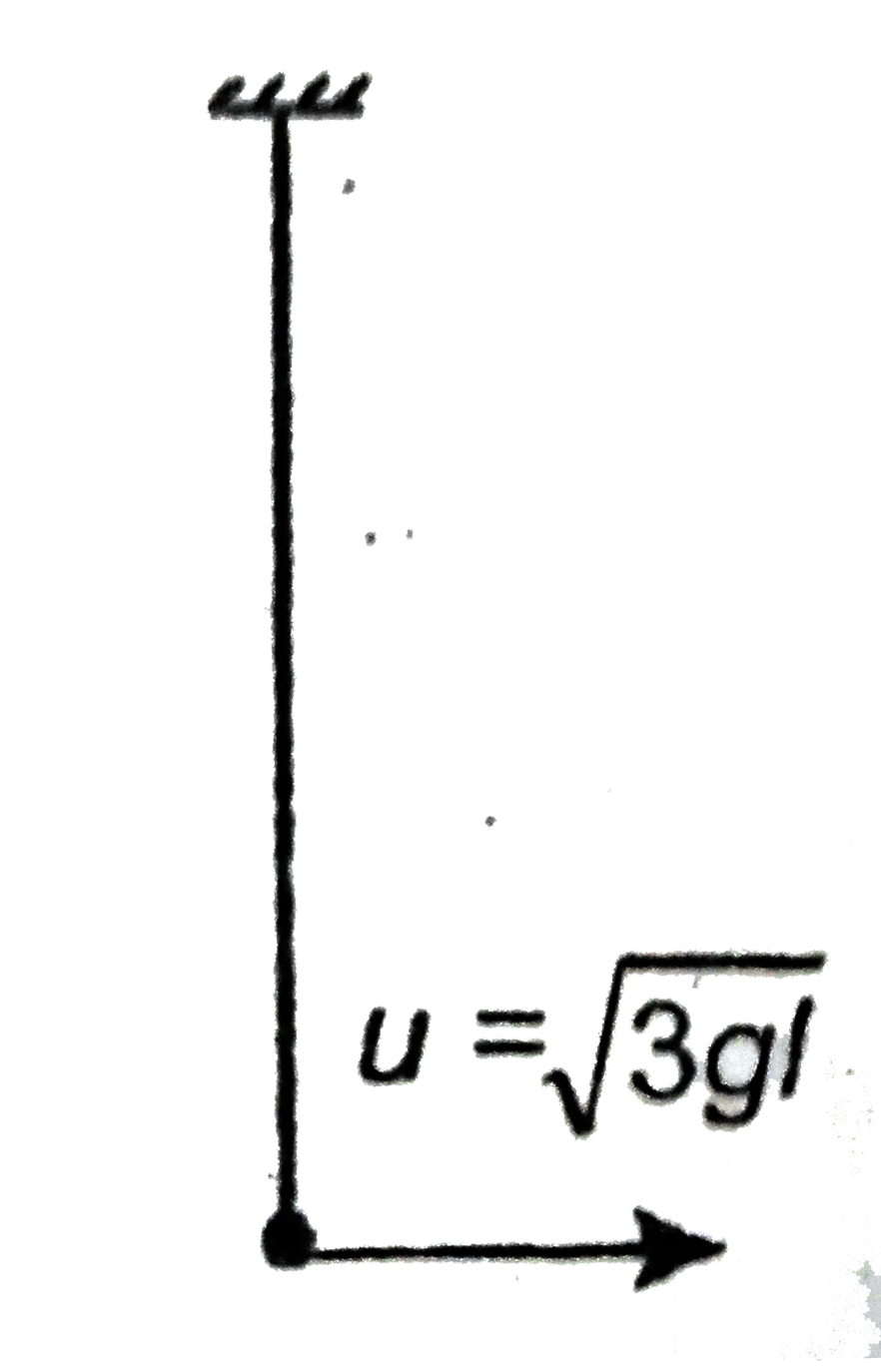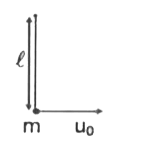A heavy particle hangs from a point O, by a string of length a. It is projected horizontally with a velocity u=√(2+√3)ag . The angle with the downward vertical, string makes where string becomes slack is :
The correct Answer is:B
To solve the problem step by step, we need to analyze the motion of the heavy particle and the forces acting on it when the string becomes slack. Here’s how we can approach this:
Step 1: Understand the Initial Conditions
The heavy particle is hanging from a point O by a string of length a and is projected horizontally with a velocity u=√(2+√3)ag.
Step 2: Draw the Diagram
Draw a diagram showing the point O, the string of length a, and the particle at an angle θ from the vertical when the string becomes slack.
Step 3: Identify Forces Acting on the Particle
At the position where the string becomes slack, the forces acting on the particle are:
- The gravitational force mg acting downwards.
- The tension T in the string acting along the string.
Step 4: Resolve Forces
Resolve the gravitational force into two components:
- mgcosθ (along the string)
- mgsinθ (perpendicular to the string)
Step 5: Apply the Centripetal Force Condition
At the moment the string becomes slack, the tension T becomes zero. Therefore, the centripetal force required for circular motion is provided solely by the component of the gravitational force:
T−mgcosθ=mv2a
Since T=0 when the string becomes slack, we have:
−mgcosθ=mv2a
Step 6: Apply the Work-Energy Theorem
Using the work-energy theorem, the initial kinetic energy plus the initial potential energy equals the final kinetic energy plus the final potential energy:
12mu2+0=12mv2+mg(a(1−cosθ))
Cancel m from the equation:
12u2=12v2+g(a(1−cosθ))
Step 7: Substitute Values
Substituting u=√(2+√3)ag:
12(2+√3)ag=12v2+g(a(1−cosθ))
Rearranging gives:
(2+√3)ag=v2+2g(a(1−cosθ))
Step 8: Solve for v2
From the centripetal force equation:
0=−mgcosθ+mv2a
This implies:
v2=agcosθ
Step 9: Substitute v2 in Work-Energy Equation
Substituting v2=agcosθ into the work-energy equation:
(2+√3)ag=agcosθ+2g(a(1−cosθ))
Simplifying gives:
(2+√3)=cosθ+2(1−cosθ)
(2+√3)=2−cosθ
cosθ=2−(2+√3)=−√3
Step 10: Find θ
Thus, we have:
cosθ=−1√3
Therefore, the angle θ is:
θ=cos−1(−1√3)
Final Answer
The angle with the downward vertical that the string makes when it becomes slack is:
θ=cos−1(−1√3)
---
The heavy particle is hanging from a point O by a string of length a and is projected horizontally with a velocity u=√(2+√3)ag.
Draw a diagram showing the point O, the string of length a, and the particle at an angle θ from the vertical when the string becomes slack.
At the position where the string becomes slack, the forces acting on the particle are:
- The gravitational force mg acting downwards.
- The tension T in the string acting along the string.
Resolve the gravitational force into two components:
- mgcosθ (along the string)
- mgsinθ (perpendicular to the string)
At the moment the string becomes slack, the tension T becomes zero. Therefore, the centripetal force required for circular motion is provided solely by the component of the gravitational force:
T−mgcosθ=mv2a
Since T=0 when the string becomes slack, we have:
−mgcosθ=mv2a
Using the work-energy theorem, the initial kinetic energy plus the initial potential energy equals the final kinetic energy plus the final potential energy:
12mu2+0=12mv2+mg(a(1−cosθ))
Cancel m from the equation:
12u2=12v2+g(a(1−cosθ))
Substituting u=√(2+√3)ag:
12(2+√3)ag=12v2+g(a(1−cosθ))
Rearranging gives:
(2+√3)ag=v2+2g(a(1−cosθ))
From the centripetal force equation:
0=−mgcosθ+mv2a
This implies:
v2=agcosθ
Substituting v2=agcosθ into the work-energy equation:
(2+√3)ag=agcosθ+2g(a(1−cosθ))
Simplifying gives:
(2+√3)=cosθ+2(1−cosθ)
(2+√3)=2−cosθ
cosθ=2−(2+√3)=−√3
Thus, we have:
cosθ=−1√3
Therefore, the angle θ is:
θ=cos−1(−1√3)
The angle with the downward vertical that the string makes when it becomes slack is:
θ=cos−1(−1√3)
Topper's Solved these Questions
- ENERGY & MOMENTUMBOOK - VMC MODULES ENGLISHCHAPTER - ENERGY & MOMENTUMEXERCISE - LEVEL - 2 PARAGRAPH QUESTIONS
2 Videos
- ENERGY & MOMENTUMBOOK - VMC MODULES ENGLISHCHAPTER - ENERGY & MOMENTUMEXERCISE - JEE MAIN (ARCHIVE)
53 Videos
- ENERGY & MOMENTUMBOOK - VMC MODULES ENGLISHCHAPTER - ENERGY & MOMENTUMEXERCISE - Level - 1 PARAGRAPH QUESTIONS
3 Videos
- ELECTROSTATICSBOOK - VMC MODULES ENGLISHCHAPTER - ELECTROSTATICSEXERCISE - JEE Advanced (Archive)
89 Videos
- GASEOUS STATE & THERMODYNAMICSBOOK - VMC MODULES ENGLISHCHAPTER - GASEOUS STATE & THERMODYNAMICSEXERCISE - JEE ADVANCED (ARCHIVE )
111 Videos
Similar Questions
A heavy particle hanging from a string of length I is projected horizontally with speed √gl . Find the speed of the particle at the point where the tension in the string equals weight of the particle.
View SolutionA heavy particle hanging from a fixed point by a light inextensible string of length l is projected horizontally with speed (gl) . Then the speed of the particle and the inclination of the string to the vertical at the instant of the motion when the tension in the string equal the weight of the particle-
View SolutionA heavy particle hanging from a fixed point by a light inextensible string of length l is projected horizonally with speed √gl . Find the speed of the particle and the inclination of the string to the vertical at the instant of the motion when the tension in the string is equal to the weight of the particle.
View SolutionA stone hanging from a massless string of length 15m is projected horizontally with speed √147ms−1 Then the Speed of the particle, at the point where tension in string equals the weight of particle, is
View SolutionA heavy particle is usspended by a 1.5 m long string . It is given a horizontal velocityof √57ms. a. Find the angle made by the string with the upward vertical, when it becomes slack. B. Find the speed of the particle at this instant. c.Find the maximum height reached by the particle over the point of suspension. Take g=10ms2
View SolutionThe bob of pendulum is project with horizontal velocity of √3gf I is the length of string. Find the angular displacement of string before it becomes slack.

View SolutionA stone hanging from a massless string of length 15 m is projected horizontally with speed 12ms−1. The speed of the particle at the point where the tension in the string is equal to the weight of the particle, is close to
View SolutionThe bob hanging from a light string is projected horizontally with a speed u0. In the subsequent upward motion of the bob in vertically plane

View SolutionA particle is projected from the ground with velocity u making an angle θ with the horizontal. At half of its maximum heights,
View SolutionA particle suspended by a light inextensible thread of length l is projected horizontally from its lowest position with velocity √7gl/2. The string will slack after swinging through an angle equal to
View Solution